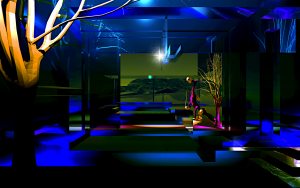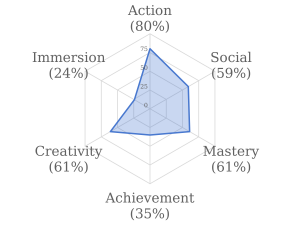Pippin Barr : A Series of Gunshots, Art Game, Let’s Play: The Shining
Pippin Barr is an Assistant Professor in the Department of Design and Computation Arts at Concordia University and Experimental Game Designer. Barr’s research focuses on Play. His Ph.D. and Masters thesis both focused on Human Computer Interaction, the concept of Play, and the use of Metaphors in games.
A Series of Gunshots is a browser based game with one control: Press Any Key. The player is presented with a situation: A view of a residence. The player is limited to seeing the world from an outside observer’s perspective. We
The sparse seemingly random controls and limited visual hints allow the player to interpret the outcomes of these series of gunshots. The game the controls reveal the true nature and intent of the game. It speaks to the random nature of violence. What goes through your head when you see a single flash and hear a single gunshot in a distant room? What goes through your head when you see multiple flashes and hear multiple shots within quick succession? A Series of Gunshots confronts gun culture, the idea of suicide, the idea of gun violence, and the idea of protection.
Game Link
Art Game is a later browser based game from Barr. It is an RPG where the player takes on the role of an artist preparing for a very large show. The game begins with the main character painting canvases and having their gallery representative/curator pick over the works for the upcoming show. After several rounds of painting, calling over the curator, and titling works the game moves to the gallery show. While at the show, the player walks around overhearing conversations about their work, overhearing gossip from the art world, and observing the other works in the show.
The game is a very realistic simulation of the art world or the art game that professional artist play: the constant creation to display loop where the artist seeks outside validation of their work from a curator or the public.
Game Link
Let’s Play: The Shining is a video game adaptation of the movie The Shining. This game can be best described using Barr’s words:
Let’s Play: The Shining conceived as being a game focused entirely on Jack’s perspective in the movie so that the player would always have the anti-hero role throughout. The main reason for that was that it seemed funny, but it’s also true that it ties in a little better with themes in the movie (and book) of control being exerted specifically on Jack to get him to do the terrible things he does. The player is then the hotel. But because I wanted to call the game “The Shining” at that time, it didn’t seem reasonable to solely represent Jack, as it wouldn’t be true to the movie. So the idea shifted to making an E.T.-esque movie-tie-in game that might have appeared on the Atari 2600 at the time. That amused me because it seemed funny to choose The Shining as your vehicle for “making a quick buck” based on a successful movie.
It is a faithful reproduction of The Shining.
Game Link



